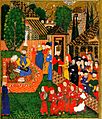Turkification facts for kids
Turkification is a process where areas or groups of people who are not Turkish in their culture, language, or background become more Turkish. This change could happen on its own, or it could be forced upon people.
Long ago, the land that is now Turkey was home to many different groups of people. These included Greeks, Kurds, Armenians, and others. Over hundreds of years, some of these groups slowly started to adopt Turkish ways of life. This was a form of cultural assimilation. Later, under a leader named Mustafa Kemal Atatürk, there was another period of forced Turkification. This time, the main goal was to change the languages spoken by these groups to Turkish.
Turkification helps explain why Turkish culture today is a mix of different influences. You can see parts of Western, Islamic, and even older Shamanistic cultures in Turkey.
Contents
What is Turkification?
Turkification is about making something non-Turkish become Turkish. Imagine a group of people who speak a different language and have unique traditions. Turkification means they might start speaking Turkish and adopt Turkish customs. This process can happen in different ways. Sometimes, people choose to learn Turkish and blend in. Other times, it is not a choice, and people are made to change their ways.
Why did Turkification happen?
This process often happened for political reasons. Leaders wanted to create a strong, unified country. They believed that having everyone share the same language and culture would make the country stronger. This idea is part of something called nationalism, which is a strong feeling of pride and loyalty to one's own nation.
Early Turkification: A Long History
Before the Turkish people arrived in the area we now call Turkey, many different groups lived there. These included ancient Greeks, Armenians, and Kurds, among others. When Turkish groups began to settle in the region, they brought their own culture and language.
Over many centuries, some of the local people gradually adopted Turkish customs. This was often a slow process. For example, people might learn Turkish to trade or to get along better with their new neighbors. This kind of change is called cultural assimilation. It means one culture slowly becomes more like another.
The Ottoman Empire and Turkification
The Ottoman Empire was a powerful Turkish empire that lasted for hundreds of years. During this time, the process of Turkification continued. The empire was very diverse, with many different ethnic and religious groups. While the Ottomans generally allowed different groups to keep their own religions, Turkish culture and language often became more common, especially in government and trade.
One example of a forced change was the devşirme system. This was when Christian boys from conquered lands were taken and trained to serve the Ottoman Empire. They were converted to Islam and learned Turkish. Many became elite soldiers called Janissaries. This was a way to bring non-Turkish people into the heart of the empire's power structure, making them part of the Turkish system.
Modern Turkification: Language and Identity
After the Ottoman Empire ended, the modern country of Turkey was formed. A very important leader named Mustafa Kemal Atatürk became the first president. He wanted to build a new, strong Turkish nation. Part of his plan involved making sure everyone in Turkey shared a common Turkish identity.
Atatürk's Language Reforms
Atatürk believed that language was key to national unity. He started a big effort to make Turkish the main language for everyone. This meant that some groups who spoke other languages, like Kurdish or Armenian, were encouraged or even forced to use Turkish. For example, new laws might have made it harder to use other languages in schools or public places. The goal was to create a single, unified Turkish-speaking nation.
This period of forced Turkification focused heavily on language. It aimed to make sure that all citizens of Turkey spoke Turkish and felt part of the Turkish nation.
The Mix of Turkish Culture
Today, Turkish culture is a fascinating blend of different influences. The long history of Turkification, both voluntary and forced, has shaped it.
- Western Influences: Turkey has adopted many ideas and customs from Western countries, especially in its government and modern lifestyle.
- Islamic Influences: Islam is the main religion in Turkey, and it has deeply shaped Turkish art, architecture, and daily life.
- Shamanistic Influences: Even older traditions from the original Turkish tribes, some of which were shamanistic (believing in spirits and nature worship), can still be seen in some Turkish customs and beliefs.
This mix shows how different cultures can come together over time, creating something unique and rich.
Images for kids


